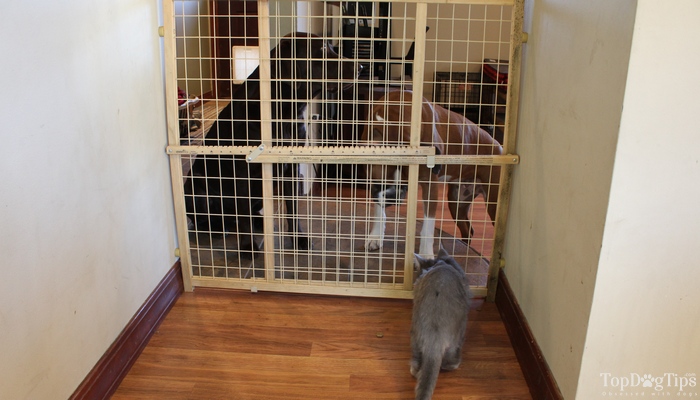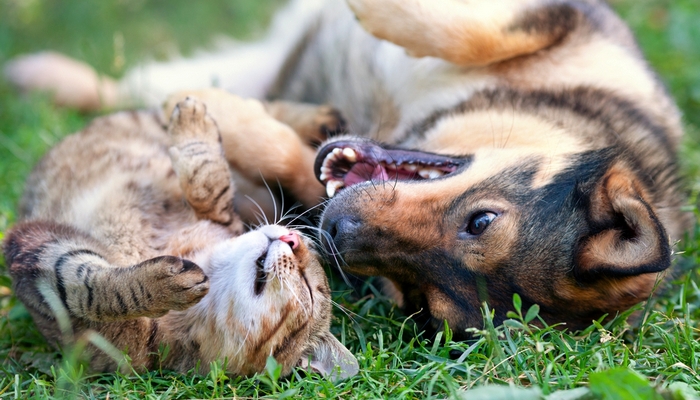Whether you already have a dog and would like to adopt a cat or vice versa, you need to plan what you'll do once you bring your new furry friend home. Learning how to introduce a dog to a cat. It's not something to take likely.
If you think your dog is friendly and won't have an issue meeting a new cat, it's not worth taking any risks. If you think your cat is easy going and won't freak out when a new dog gets in her face, you're probably wrong. Whenever two animals (no matter what species) meet for the first time, they NEED to be supervised and restrained in some way.
 Some dogs and cats get along fine from the first meeting, while others may need time to get to know each other before they are completely comfortable. Still, other animals may like being the only pet in a household. If this is the case, they'll never enjoy being around other pets.
Some dogs and cats get along fine from the first meeting, while others may need time to get to know each other before they are completely comfortable. Still, other animals may like being the only pet in a household. If this is the case, they'll never enjoy being around other pets.
The key to successfully learning how to introduce a dog to a cat is doing it gradually. You don't want to overwhelm either animal, as this could quickly result in aggression.
Once one animal shows signs of aggression the other may respond aggressively in defense. Once that happens it will be very difficult to get the two animals to feel comfortable around each other without the help of a well-trained (and expensive) professional.
ALSO READ: 22 Cat Products That You Can Safely Use with Dogs
How to Introduce a Dog to a Cat
Before the Introduction
For the purpose of this article, I'm going to assume that you're already a dog owner and you're bringing a new cat into your home. If it's the other way around, you'll still want to follow the same procedure.
Consider the personality of your dog before you even consider adopting a cat. Does your dog typically get along with other animals and strange people? Does your dog ever show signs of aggression around his toys or food? Do you have any reason to believe that he enjoys being the only pet in the home?
You may not be able to answer these questions right now, and that's okay. If your dog has never been around another pet, this will be a brand new experience and you'll need to be extra cautious.
Keep in mind that if your dog has no experience with other pets, you should make the shelter, rescue or breeder that you're adopting from aware of the situation.
Some shelters or rescue organizations may want you to bring your dog in and have him meet the cat at their facility. I DO NOT recommend this. Your dog will be overwhelmed with the new sights, smells and sounds at the shelter. Introducing him to a new animal in that type of environment is just asking for trouble.
WATCH/READ: How To Introduce Your Puppy To An Existing Dog
Signs of Aggression
Before the you begin to learn how to introduce a dog to a cat, be sure you're looking for any signs of aggression. You'll need to be extremely observant. Catching the subtle signs of aggression and intervening before a fight starts could save the animals from a lot of pain or even death.
Signs of aggression in dogs include:
- staring
- growling/barking
- lip curling
- laying ears back against head
- snapping
- carrying tail high or stiffly wagging it
Signs of aggression in cats include:
- direct stare
- stiff, straight-legged upright stance with stiffened rear legs or rear end raised and back sloped down toward the head
- stiff tail that is lowered or held straight down
- hair on back and tail sticking up
- growling, hissing or yowling
- swatting with paws
- exposing teeth
The Introduction Part
 Because your dog has been living in your home, he is used to the environment and it smells like him.
Because your dog has been living in your home, he is used to the environment and it smells like him.
You need to give the cat time to explore the home and smell your dog without the dog being present. Send him for a walk with another member of your family. This will also help to tire your dog out, which will be beneficial for the initial introduction.
Let the cat have a significant amount of time to explore. He'll likely be nervous at first, but you'll notice him becoming more comfortable with a little time. Make sure that she has time to learn where the food, water and litter box are.
Once you can tell that she's getting more comfortable, place her in a cat carrier and put her in a room with the door closed. Let your dog back into the house to explore and smell the scent of the cat. Allow him to get comfortable in the house again before moving on.
As you'll see in my video, the best way to learn how to introduce a dog to a cat face-to-face is with the help of a pet gate. When you have dog gates at home, they will keep the animals separated while still allowing them to see and smell each other.
If you can't use a pet gate, keep the cat in the carrier during this initial introduction. This is not preferable, because the cat may feel trapped in the carrier and be more scared than she would if she knew she had the means to get away from the dog.
If the cat is extremely skittish, you should keep her in a carrier even if you have a pet gate. This will keep her in one area to allow the animals time to sniff each other.
ALSO READ: How to Adopt a Dog If You Already Have a Cat
After the Barrier Introduction
Once the animals have gotten used to each other through the pet gate or carrier, it's time to introduce them with no barrier in between. It's best to keep both pets on a leash, so you'll need someone else to help you with this part of learning how to introduce a dog to a cat.
Start with the animals at a distance of about 10 feet. That's close enough for them to smell each other without being able to reach each other. Remember, look for any signs of aggression during this time.
Leash pulling is to be expected, but if the animals are lunging toward each other or pulling on the leash while showing signs of aggression toward the other animal, STOP WHAT YOU'RE DOING. Any signs of aggression should be taken very seriously, and you're not trained to deal with aggressive animals.
You'll need to enlist the help of a trained professional with experience in introducing dogs and cats if this is the case.
Hopefully all will go well and the animals will be curious about each other. If this is the case, you can slowly move them closer together. Close the gap gradually until they are able to be nose to nose. Give them plenty of time to get used to each other before moving on.
Once they've been introduced while on a leash and things seem fine, you can let the cat off the leash. Allow the dog to follow the cat and sniff the areas that the cat goes to. When you're sure that the dog is comfortable and is showing no signs of aggression, you can let him off the leash too.
Supervision is still critically, and the animals should not be left alone together until you're 100% sure that there won't be any problems. Do not leave your animals alone together, and be sure to keep one of them in a soft or plastic pet crate while you're out of the house. You can't be too careful in this situation, as any issues could turn into a very serious situation in the matter of just a few seconds.
READ NEXT: Best Dog Gates – Comparing Primetime Petz vs. Carlson vs. Evenflo
















